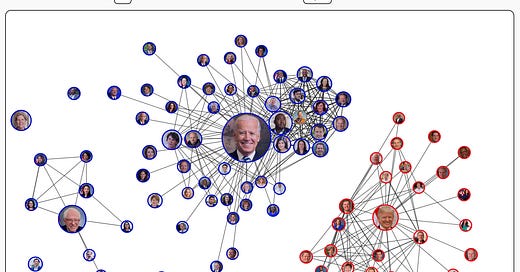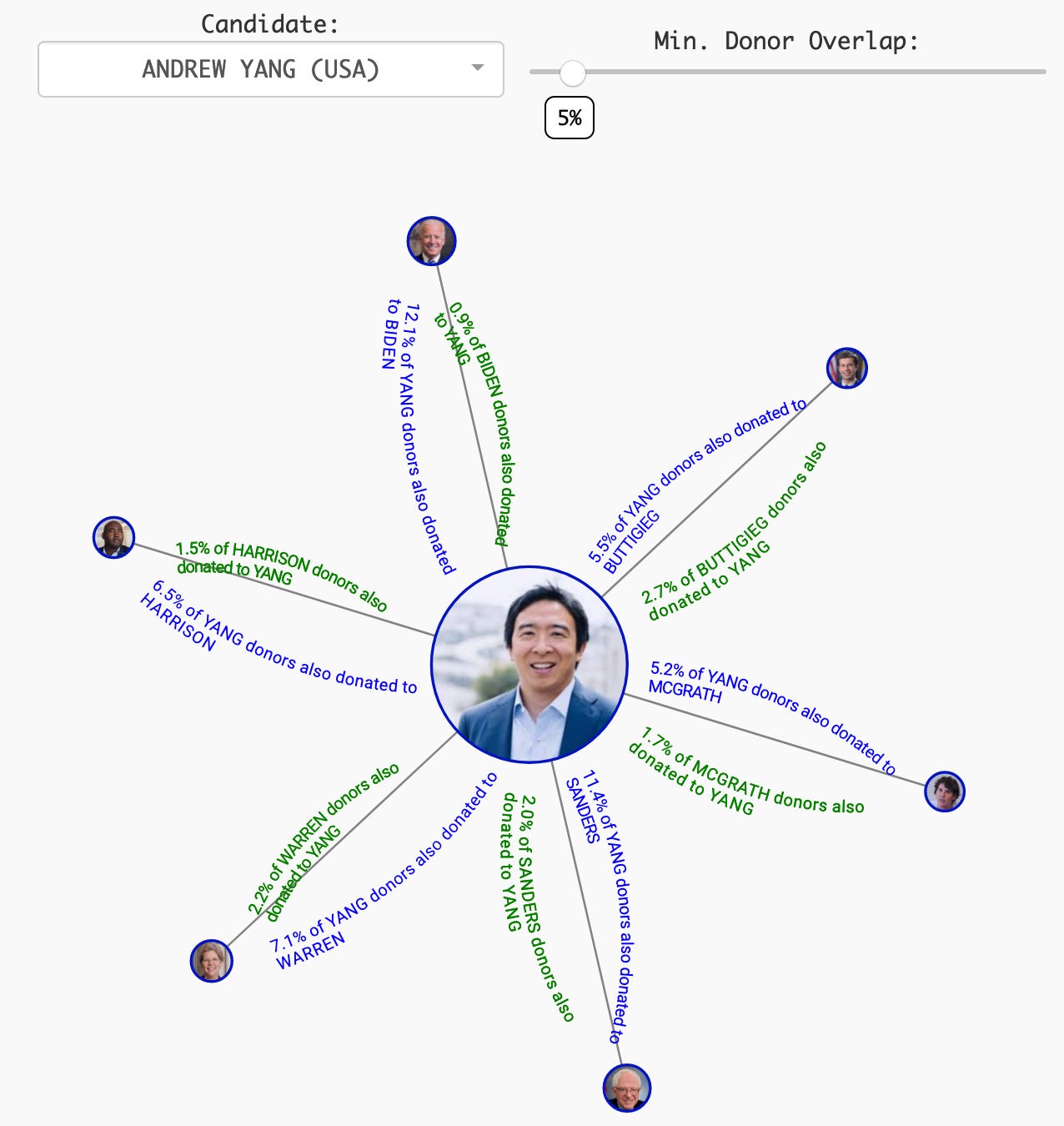How Money Clustered Around 2020 Candidates
Data viz explains Trump's continued hold on GOPers, splits among Dems and Andrew Yang's unique base.
I just stumbled on a recent data visualization by Sam Learner, a data analyst at Tech Elevator, that allows you to explore how much the donor base for federal candidates in 2020 overlapped with each other. Not surprisingly, there’s almost no overlap between Democratic and Republican candidates among their individual donors—if Learner had included PAC data there would be plenty of hedging by corporate PACs giving to candidates of both parties. But two things are really fascinating to see. First, the Republican donor base is quite tightly centered on The Former Guy. For all the Republican candidates who had at least 30,000 individual donors, at least 40% of their donors overlap with the Orange Cheeto and each other. Rep. Daniel Crenshaw is the first to break away from the Republican pack, when you push the threshold on Learner’s “minimum donor overlap” slider past 42%. (I highly recommend going to the site and playing with the sliders, though my screenshots below give you some highlights.) This means there isn’t much personal or ideological variation among the Republican donor base. And it also explains, yet again, why so many current Republican office holders are cleaving to The Former Guy. Take Rep. Elise Stefanik, who has moved into the top tier of the Republican House leadership: 53.6% of her 2020 donors also gave to Trump. Almost 60% of Republican minority leader Kevin McCarthy’s donors gave to Trump. Just over 50% of Sen. Susan Collins donors gave to Trump.
Democrats have a somewhat more varied individual donor base. At that same threshold of 40% overlapping (see above), you see fair number of outliers from the main Democratic cluster around President Joe Biden. One is a cluster around Senator Bernie Sanders who shared at least 40% of the same backers (Reps. Alexandria Ocasio-Cortez, Ayanna Pressley, Rashida Tlaib, Ilhan Omar, and Jamaal Bowman, all of whom got elected, and two challengers Jessica Cisneros and Shahid Buttar). The others are loners who managed to build their own semi-independent bases of support with relatively little overlap: Sen. Elizabeth Warren, Sen. Ed Markey, Sen. Kirsten Gillibrand, Transportation secretary Pete Buttigieg, Kentucky senate challenger Charles Booker, Rep. Tulsi Gabbard, author Marianne Williamson, and failed tech entrepreneur Andrew Yang.
If you lower the threshold slider for overlapping donors at least 33%, the Democratic network tightens, with only Gabbard, Williamson and Yang still floating out there on their own (see below).
But here’s what’s really interesting: Yang has very few donors in common with other Democrats. It’s only down at the 12% level that his donor base overlaps with the rest. That is to say, of the 333,000 individual donors to Yang (through October 15, 2020, the data set used by Learner), only about 40,000 of them also gave to Joe Biden, the candidate he had the most donors in common with.
At the more granular level, you can see that Yang’s donors had a few additional candidates they liked: Sanders, Warren, Jamie Harrison, Buttigieg and Amy McGrath. But for the most part their donor networks only modestly overlapped (see below)
So, we already knew this, but the #YangGang, an internet-driven grassroots phenomenon that trended male, young, and tech-bro was real and sui generis. Something close to 300,000 people who were not interested in any of the other Democratic candidates for office in 2020 chose to give to Yang. Could this be the base for some kind of independent political formation, say, a Blockchain Party or a Universal Basic Income bloc? Since losing his bid for the presidency, Yang has thrown himself into the New York City mayoral race and current polls still suggest that he could come out on top, or a close second to Brooklyn borough president Eric Adams or former city sanitation commissioner Kathryn Garcia. But if Yang loses later this month, he still has an intriguing political future if he wants to play a wild-card role in national affairs: his donor base is there. (Ironic footnote: Learner was a 2016 Venture for America fellow, according to his LinkedIn bio.)
-Bonus link from Learner to save for a rainy day: River-runner is a new interactive map of the United States he recently released that shows the path of a raindrop from anywhere in the contiguous United States.
Privacy, Shmivacy
-Starting next Monday, Amazon is turning on Amazon Sidewalk, and will automatically connect all your Amazon devices—including Alexa, Ring, Echo, security cams, outdoor lights, motion sensors and Tile trackers—into a wireless mesh network connected to your neighbors and everybody else. The company says it’s doing this “at no charge to customers” and that it will simplify device set up and extend their working range. Just because it can, Amazon is making this shift the new default setting for all its users. If you don’t want to be connected and risk having your personal conversations and security systems potentially available to others, you have to opt out. As Ars Technica’s Dan Goodin explains, this is a huge privacy gamble on a mesh technology that’s never been widely tested.
-Oh, and while it’s undermining your privacy for the sake of, what, convenience, Amazon is also harming American warehouse workers at twice the rate of other big employers like Walmart, according to new work-injury data from OSHA, Jay Breen and Chris Alcantara report for The Washington Post.
-Speaking of privacy gambles, New York’s vaccine passport, Excelsior, has been downloaded more than 1 million times since its launch, but as Sharon Otterman reports for The New York Times, it took Albert Fox Cahn of the Surveillance Technology Oversight Project just 11 minutes to download someone else’s Excelsior pass using information they had posted on social media. Each pass, which is basically a glorified QR code, can be loaded onto a limitless number of devices or printed out and copied, she notes. But it’s made with BLOCKCHAIN technology, and by IBM, no less!
-On a more positive note, state lawmakers are beginning to clamp down on the use of personal genealogy websites to trawl for DNA matches from crime scenes. As Virginia Hughes reports for The New York Times, Maryland and Montana have both passed new laws restricting law enforcement’s use of genetic genealogy. The Maryland law specifically requires that genealogy websites explicitly get the permission of their users before allowing law enforcement to run a match.
This is Civic Tech
-Here’s a great essay (and timeline) from Gina Glantz, the founder of Gender Avenger, about how she teamed up with a bunch of civic technologists including Matt Stempeck, Nate Matias and Yonatan Kogan back in 2014 to start using conference hashtags to address the gender imbalance in the public arena. Most notable: Gender Avenger has now raised its bar, expecting panels and other conversations in public dialogues to be at least 50% women and 20% women of color to be considered gender equal and inclusive.
-Who says canvassing is just for getting elected? In April, Pennsylvania state representative Rick Krajewski teamed up with Philadelphia city councilor Jamie Gauthier, reactivated his campaign volunteer program, and got more than 100 volunteers involved contacting local residents in order to address questions about COVID vaccine access and hesitancy. They also worked with an organization that helped drive voters to early voting locations last fall to offer rides to and from vaccine appointments. By May 27, they had knocked on more than 7,000 doors and talked to 2,000 neighbors face to face, with 3,000 more to go. “These conversations were different than typical voter outreach conversations. These convos were about listening, building trust, and offering resources,” Krajewski says. “The nature of these conversations made is so they took longer, and often had an impact beyond just the person at the door.” #VaccinateWSWPhilly is now hard at work knocking on the doors of every person living in the 3rd councilmanic district.
-Attend: Technologists for the Public Good, a new professional association, is launching with a virtual town hall conversation June 9 from 5:00-6:00pm EDT led by Beeck Center Fellow Jenn Noinaj. Register here.
-Apply: The good folks at New_ Public are looking to hire a part-time staff writer.







